JNC, Barton-Wright, Self Defence with a cane part 1 (original) (raw)
Journal of Non-lethal Combatives, February 2000
Self-defence with a Walking-stick: The Different Methods of Defending Oneself with a Walking-Stick or Umbrella when Attacked under Unequal Conditions (PartI)
By E.W. Barton-Wright [EN1]
From Pearson’s Magazine, 11 (January 1901), 35-44.
Contributed by Ralph Grasso. Editor’s notes by Ralph Grasso and Joseph Svinth copyright © 2000 all rights reserved.
Introduction
It must be understood that the new art of self-defence with a walking-stick, herewith introduced for the first time, differs essentially from single-stick or sword-play; for a man may be a champion in the use of sword or single-stick [EN2] and yet be quite unable to put a walking-stick to any effective use as a weapon of defence. The simple and sufficient reason to account for this is that both in single-stick and sword-play a cut is always taken up by the hilt of the weapon, whereas if you attempted to guard a blow with a walking-stick -- which has no hilt -- in the same way as you would with a sword, the blow would slide down your stick onto your hand and disable you. Therefore, in order to make a stick a real means of self-defence, it has been necessary to devise a system by which one can guard a blow in such a way as to cause it to slide away from the hand instead of toward it, and thus obviate the risk of being disarmed by being hit upon the fingers.
After some fifteen years of hard work, such a system has been devised by a Swiss professor of arms, M. Vigny. [EN3] It has recently been assimilated by me into my system of self-defence called "Bartitsu."
In the art of self-defence with a walking-stick, the stick is held in the hand with the thumb overlapping the fingers, and not, as in single-stick or sword-play, with the thumb resting on the blade. The stick is therefore manipulated with the wrist -- and not with the fingers as in sword-play -- and the blows are given by swinging the body on the hips -- and not merely by flips from the elbow. In this way blows can be made so formidable that with an ordinary malacca cane it is possible to sever a man's jugular vein through the collar of his overcoat.
No. 1. -- The Guard by Distance -- How to Avoid any Risk of being Hit on the Fingers, Arm, or Body by Retiring out of the Hitting Range of your Adversary, but at the same time Keeping Him within the Hitting Range of your Own Stick.
The mode of defence I am about to describe I have called "The Guard by Distance," to distinguish it from "Guards by Resistance." It will be noticed that in this method of defence the man attacked does not attempt to guard a blow by raising his hands to stop it, but simply by changing front from left to right foot -- in other words, by swinging round from his original position, in which his left foot is advanced in front of his right, to a position in which his right foot is in front of his left. By so doing, he avoids being hit himself, with the certainty of being able to hit his adversary.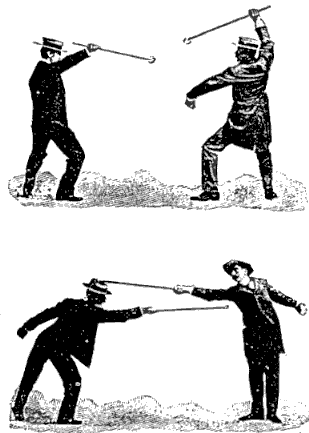
When guarding by distance, you take up the position of rear-guard -- that is to say, you stand with left foot forward, slightly bent knees, right arm held above the head, and left arm thrown well out in front of you. I ought to state here that this is not a very easy attitude to assume, and that a certain amount of training in physical culture is necessary before it can be adopted with ease; but when you have acquired the requisite suppleness of body it is a very safe and reliable position to take up.
You must be careful to maintain the same distance between yourself and your adversary, which you originally take up, by retiring (right foot first) as he advances, and advancing (left foot first) as he retires. Then play a waiting game, and entice your opponent to strike at your arm or head by exposing one of the two, so that you are prepared to retire instantly upon the first sign of danger.
Your opponent, encouraged by the apparently exposed position of your left arm, naturally strikes at it, but you, anticipating the attack, withdraw it very quickly, and swing it upwards behind you. This upward sweep of the arm automatically causes you to swing your left foot well behind your right, and to draw in the lower part of your body out of your opponent's reach; at the same time it imparts the initial momentum to your right arm, and assists in bringing your stick down very quickly and heavily upon your adversary's head before he has time to recover his balance after over-reaching himself in trying to hit you.
No. 2. -- Another Way to Avoid being Hit by Retiring out of Range of your Adversary's Stick.
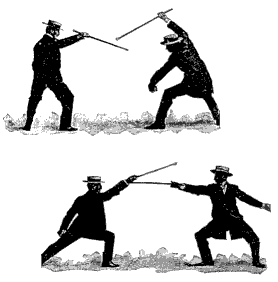
It is always most desirable to try to entice your adversary to deliver a certain blow, and so place yourself at a great advantage by being prepared to guard it, and to deliver your counter-blow. To induce your opponent to aim a blow at your head you take up the same position of rear-guard as described in the last trick, but instead of exposing your arm so much, you push your head more forward, leaving it apparently quite unguarded. Your assailant foolishly accepts the invitation, and you promptly draw yourself out of danger by swinging your left foot behind your right. This movement gives an automatic counter-movement to the right side of your trunk and helps you to swing in a very heavy right-handed blow across his wrist, which might thus easily be broken.
No. 3. -- Double-handed Stick-play -- Showing the Best Way to Handle with Two Hands a Stick which is too Heavy to Manipulate Quickly with One Hand, when Attacked by a Man Armed with a Light Stick.
In mastering the art of self-defence with a stick it is important to learn how you may best wield your weapon with two hands, otherwise you might be at a serious disadvantage when carrying a heavy stick which you could not use freely with one hand, if attacked by a man carrying a lighter cane with which he could make quick, one-handed play. Your assailant's movements in this case would be so much quicker than yours that you would be at a very serious disadvantage with your heavier weapon.
The preparatory position for delivering a double-handed blow at your adversary's head is a position of guard, in which you hold the stick with both hands horizontally above your head, with thumbs away from your face and hands at the ends of the stick. The beauty of this position lies in the fact that your opponent does not know which end of the stick you intend to use to hit him with. We will suppose that you are holding the stick with the heaviest end in your right hand, and that you propose to hit him with this end.
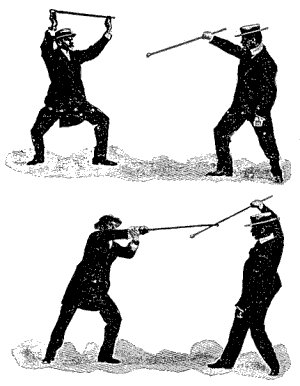
The blow is delivered thus -- you slide your right hand quietly off the right-hand end of the stick, and bring it back again, holding the stick with the thumb on the side nearest your face. Then, using your left hand as a pivot, you slide your right hand up to your left with a circular motion, thus delivering a strong side blow at your adversary's face.
Should you wish to strike our opponent with the opposite end of the stick -- the lighter end -- you would slip your left hand off the left end of the stick, bring it back with the thumb on the side nearest your face, and then slide your left hand towards your right, to impart a circular motion to the stick as before.
A person requires to be very supple in the shoulders to work a stick gracefully and well with two hands.
No. 4. -- How to Defend Yourself, without Running any Risk of being Hurt, if you are carrying only a Small Switch in your Hand, and are Threatened by a Man with a very Strong Stick.
Imagine that you are walking in a lonely part of the country, carrying a light switch or an umbrella, when suddenly a foot-pad bars your way, carrying a stout stick, with which he threatens you.
It is obvious that under these conditions if you gave your assailant time to assume the offensive, he would have no difficulty in breaking down any slight guard you might offer, and in felling you to the ground. Knowing this disadvantage, and without giving him time to realise it, you must at once attack.

You should aim a vicious blow at your assailant's head, holding your hand very high in order to force him to guard high. Simultaneously, you should jump forward from the attacking position, shown in the second photograph, to the position shown in the third photograph, and strike him with the open hand high up on the chest, pulling his foot away from beneath him at the same time -- in order to disturb his balance, and destroy his power to hit you. You could now strike your adversary such a blow with your fist on the face as to render him unconscious, or, of course, you could belabor him with your stick if it were suitable for the purpose.
No. 5. -- Another Way to Defend Yourself when your Adversary is Armed with a Stout Stick, and you are Carrying only an Umbrella or an Unreliable Cane.
In case the student of the art of self-defence with a walking-stick finds difficulty in mastering the preceding method of defense, here is an alternative, equally effective, and, perhaps, somewhat safer for beginners to practise.
As before, appreciating the unreliability of your weapon, you assume the offensive at once before your opponent has time to discover your disadvantage. You begin operations precisely as described in the last trick, by striking high at your assailant's head, and forcing him to guard high.Simultaneously you spring into the position shown in the third photograph, seizing your opponent just below the elbow, thereby completely disturbing his balance, and so preventing him from hitting you. You can now deliver a heavy right-handed blow with your fist upon his chin, or over his heart, which will render him unconscious.
A nine-stone [126-pound] man who is active, and who timed this movement nicely, could completely upset the balance of a man twice his weight and bring him to the ground in a second. [Judoka Yukio Tani worked for Barton-Wright, and was quite capable of accomplishing this feat.]
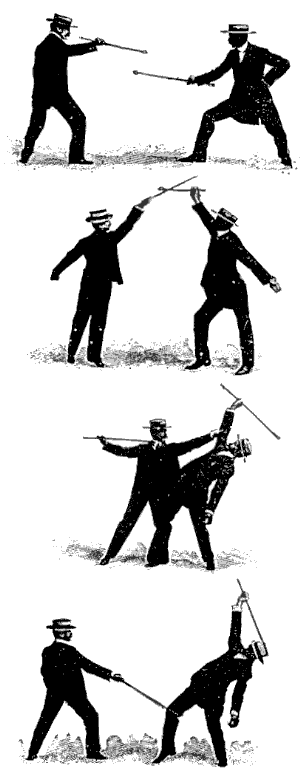
In case you are carrying a stick which might be strong enough to deliver a heavy blow, another method of attack is as follows: After you have disturbed your assailant's balance by seizing him by the elbow, you retire quickly, by withdrawing your left foot well behind your right, and then, holding your head and body well on one side out of possible danger, you deliver a heavy blow with your stick across your assailant's kneecap is very dangerous, and would utterly incapacitate a man if well delivered. It is advisable, therefore, not to hit too hard when showing the trick to a friend.
No. 6. A very Safe Way to Disable a Boxer who Attempts to Rush You when You are Armed with a Stick.
Imagine the case of a man armed with a serviceable stick being attacked by a skilled boxer. One of the safest and most reliable methods of defence against a boxer's fists is as follows: --
The man with the stick faces the boxer in the back-guard position -- that is to say, with his left foot and arm extended, and his right arm guarding his head. His left arm is thus free to guard his face or body, if, by any chance, he should fail to evade the blow.
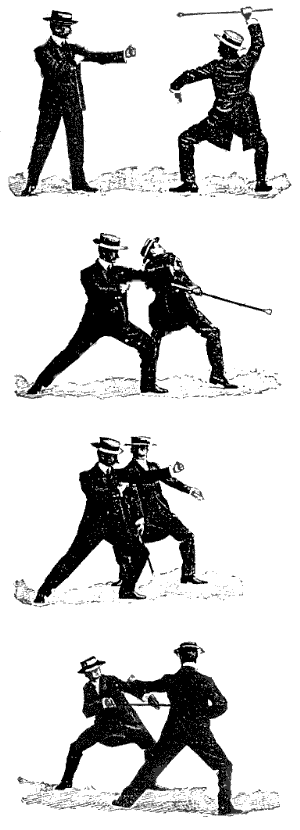
As soon as the boxer opens his attack with a direct blow upon the man with the stick, the latter jumps with one movement to the former's left, bending well forward in a crouched position, so as to avoid any possibility of being hit. Then, turning half round on his left toe, and drawing his right foot in a line with his left, he makes a low, back-handed sweep with his stick, and strikes the boxer across the knee, disabling him, and bringing him to the ground.
But for the sake of argument, we will suppose that in the excitement of te engagement the blow missed the boxer's knee, and struck him on his shin, in which case he might still be able to show fight. Quickly recovering his balance, the boxer turns on his left toe by stepping to the right with his right foot, faces his opponent, and puts in another blow. But here, again, the man with the stick anticipates the move, and bayonettes the boxer in the heart before the blow can fall. As his stick gives him a longer reach than the boxer's, he runs no danger, and the strong, upward thrust with the stick should completely incapacitate his adversary.
I should like the reader to thoroughly understand that in every form of self-defence the first and most essential thing is to have a well-trained eye. This trick is entirely dependent upon the quickness of the eye in judging the right moment to jump on one side, so that the boxer does not become aware of the fact until he has struck at you and overreached himself, when it is too late for him to make good his disadvantage.
No. 7. -- A Safe Way for One Man to Disable Another when both are Equally well Armed with Sticks.
Supposing that you are attacked by a man armed, like yourself, with a stout stick, here is a very pretty way to disable him.
Standing in the position of front guard, right foot forward, knees bent, right arm extend, you invite an attack at your head by holding your guard rather low. Your opponent accepts the invitation, and leads off at your head. You parry -- an easy matter, as you are prepared for this blow -- and simultaneously jumping well to your opponent's right, you crouch down and make a low, sweeping cut at his knees, which will bring him to the ground.
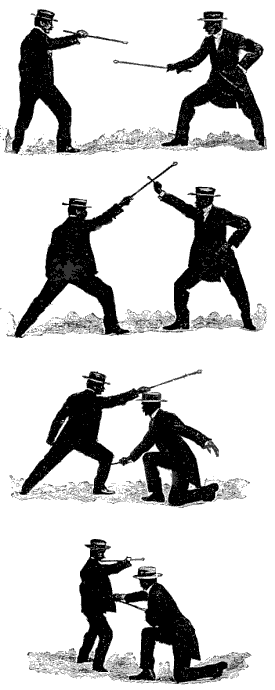
If, however, by any chance this result is not achieved, because your blow has fallen upon your opponent's shin instead of upon his knee, you will still have the best of the situation. Finding that you have got under his guard, your adversary will draw back his right foot and prepare to give you a back-handed cut across the face. You, however, foil this attempt by keeping too close to him to admit of this, and bayonette him with the point of your stick.
I specially recommend this, as well as the foregoing trick, to the attention of the reader, whether lady or gentleman, both being very easy and most effective. The most difficult part of the trick is to learn how to make your opponent lead off in the way you wish. But this becomes very simple with a little practice.
No. 8. -- One of the Safest Plans of Defence for a Tall Man to Adopt, who has not much Confidence in his own. Quickness and Knowledge of Stick-play, when Opposed to a Shorter and more Competent Opponent.
A tall, slow-moving man, attacked by a quick, short opponent, is at an immense disadvantage, as the short man delivers his attacks at lightning speed in unexpected quarters, and so reduces any possible advantage the other may hold in size and reach. Under the circumstances it would be advisable for the tall man to try to induce his opponent to deliver a blow for which he will be fully prepared.

This he will best do by taking up the rear-guard position, standing with his left foot forward, left arm extended, and right arm above the head, as previously described. He then throws his left arm forward as a bait. In ninety-nine cases out of a hundred the bait will prove irresistible. No sooner, however, does the short man begin to move his stick, with the intention of bringing it across the tall man's arm, than the latter must jump within the former's guard, in order to break the force of his blow as it falls, then seizing the other's stick, the tall man can belabor this opponent's head.
Of course, it is understood that if the tall man has only got a weak stick or umbrella in his hand, which would only be of use in making the necessary feint to get an opening, directly he obtained the advantage shown in photo No. 2, he would use his fist to strike his opponent in the face or over the heart in order to disable him.
No. 9. -- How to Defend Yourself with a Stick against the most Dangerous Kick of an Expert Kicker.
The student of the art of self-defence with a walking-stick might think it hardly worth while to study any particular method of defending himself which might insure him against an attack by a savater, or foot-boxer. You might suppose that there would be no great difficulty in guarding a high kick, provided you carried a stout stick in your hand. Those who have seen savaters at work, however, and realise the extraordinary swiftness of the kicks which they plant on their opponents' bodies, will understand that scientific kicking can only be guarded with certainty by a scientific method of defence.
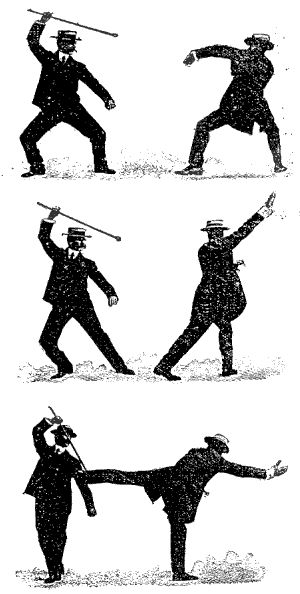
Taking up a position of rear-guard, with left arm extended to ward off a possible kick at the small of the back, hip, or left side, you describe circular cuts in a left to right downward direction with your stick. Your opponent, standing well out of reach, prepares to do what in French boxing, or la savate, a called a "chassé" -- that is, from his original position, with his left foot and left arm extended, he places his right foot behind his left so as to enable him to approach within kicking distance if the opportunity presents itself, and, at the same time, to keep his body and head well out of danger. Then, seeing an opening, he places his right heel firmly on the ground and aims a kick with his foot at your heart.
Anticipating the danger, you transfer the whole weight of your body from your left to your right leg, which enables you at the critical moment to withdraw your foot very quickly -- to avoid a kick on the shin in case of a diversion in the attack -- and at the same time assists you to draw your body out of danger. You then bring your stick so heavily down on your adversary's ankle as to break it.
If you wish to defend yourself against kicks lower down on the body, you employ exactly the same means of defence, but as it is not necessary to hold the arm so high in describing the circular cuts, it is very much easier to defend yourself. The objects of describing circular cuts, by the way, as opposed to a direct cut, is that you are very apt, in the latter case, to miss the kicker's leg, whereas in the former case you cannot fail, not only to deliver your blow, but also to ward off and divert the kick.
No. 10. One of the Best Ways of Knocking Down a Man in a General Scrimmage, when there is not Room to Swing a Stick Freely.
When a man finds it necessary to defend himself in a street fight, or the like, he may not have room to swing a stick freely. One of the best methods of using a stick as a weapon under these circumstances is to pass it between the legs of the assailant, and, by pressing it sharply against the inside of one of his thighs, to cause him to lose his balance.
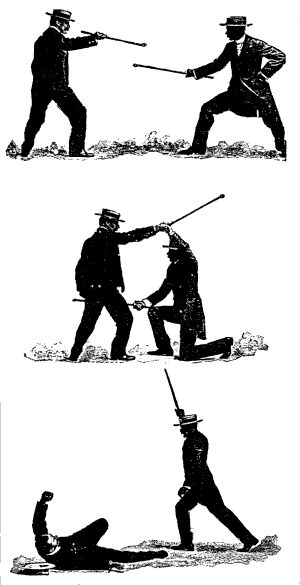
In order to carry out the trick effectively on a single assailant, when there is no crowd, you should stand in the front guard position, and make a cut at the side of your opponent's face. While he raises his hand to guard his face, you seize his uplifted with your left hand, crouch down and pass your stick through his legs, exerting sufficient leverage to throw him on his back.
Another method is to take up the back position guard, standing with your left foot forward and your right arm above your head, which you must purposely expose in order to induce your opponent to strike at it. At the moment when he attempts to hit you on the head, you must slip under his guard, and seize his right wrist. Now pass your stick between his legs, and throw him upon his back.
To employ the same trick in a crowd it is only necessary to stoop, cover your face well with your arm and hand, and to keep diving with your stick between people's legs, upsetting them right and left.
{In our next issue we hope to give a further selection of these remarkable feats. -- Ed., P.M.]
Editor's Notes (hit yoru back button to return to the text)
EN1. Edward William Barton-Wright was born in India in 1860 and educated in Germany and France. While working as a mining engineer in Japan during the 1890s he trained in jujutsu and judo, and upon moving to London in 1899, he opened a self-defense academy at which he and his mostly Japanese instructors taught a system of self-defense that he called "Bartitsu." The method was limned in several British magazines, and featured as "Baritsu" in Arthur Conan Doyle's "The Adventure of the Empty House."For further details of Barton-Wright's life, see Graham Noble, "An Introduction to W. Barton-Wright (1860-1951) and the Ecclectic [_sic_] Art of Bartitsu,"Journal of Asian Martial Arts, 8:2 (1999), 50-61. For details of Sherlock Holmes' martial arts, see Richard Bowen, "Further Lessons in Baritsu,"The Ritual-Review of the Northern Musgraves Sherlock Holmes Society, 20 (1997), 20, 22-26.
EN2. The English single stick, said Richard Burton in A New System of Sword Exercise for Infantry (London: William Clowes and Sons, 1876), is "a cane or light cudgel with a basket-hilt covering the back of the hand, like the imperfect guard of the Highland Clay-more; it is straight, not curved, and as the rod has no edges, so in practice every blow equally represents a cut."
EN3. According to Alfred Hutton, The Sword and the Centuries (London: Grant Richards, 1901; New York: Barnes & Noble, 1995), page 361: "Pierre Vigny, a professor from Switzerland, … unites in himself the qualities of a champion player and of a careful, judicious teacher of his art… Our time-honoured English singlestick is not to be compared to it. In the first place, the player is not hampered with a buffalo or wicker hand-guard, a fact which of itself lends variety to the play, for the man can, and does, frisk his cane about from one hand to the other, so that his opponent can never precisely tell which hand will deliver the attack, and careful practice of the various lessons will shortly make the student pretty nearly ambidextrous. One of the first things to understand in such play as this is to preserve the hand which holds the weapon, a thing which an occasional tap on the knuckles impresses on one's memory." Vigny's method was la lutte Parisian, and combined armed and unarmed techniques from savate, chausson, la canne, la baton, la baionnette, and English boxing.